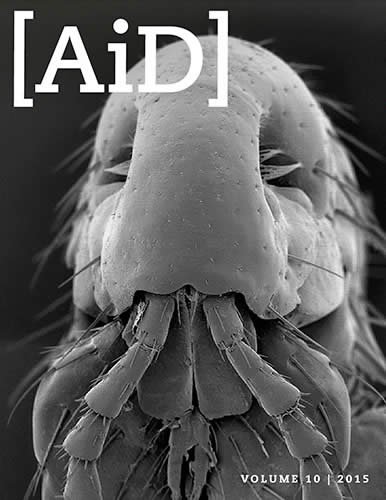
Will Fish Fossil Change Evolutionary Tree?
News to Know
Abstract
Did jawed vertebrates start out with bones or not? Evolutionists want to know.
News Sources
- ScienceDaily: “Two-faced Fish Clue that Our Ancestors 'Weren’t Shark-like’”
- Science News: “Ancient Fossil May Rewrite Fish Family Tree”
X-ray analysis of a tiny fossilized fish’s bony skull suggests that cartilaginous fish (such as sharks) are not as primitive as once claimed and, conversely, that we humans have kept many “primitive” features in our heads. At least those are the conclusions of a team of paleontologists who have recently applied modern high resolution CT X-ray technology to a 1-centimeter skull discovered in 1972 in Siberia. It was found near the Sida River in Devonian rock conventionally dated 415 million years old. Its mosaic of features, researchers believe, reveals something about the evolutionary history of sharks, bony fish, and indeed all vertebrates with jaws, including people.
Cartilaginous fish have traditionally been viewed by evolutionists as more primitive than bony fish, but the ancient date assigned to this mosaic turns that part of the evolutionary tree of life on its head and redefines just which is primitive and which is more highly evolved. Therefore, Oxford University paleontologist Matt Friedman, coauthor of the report published in Nature, says, “This mix of features, some reminiscent of bony fishes and others cartilaginous fishes, suggests that humans may have just as many features that you might call ‘primitive’ as sharks.”
Looking Back to the Future?
Named after Janus—the two-faced Roman god of bridges, crossroads, entrances, and exits—Janusiscus schultzei has long been classified as a bony fish based on its external appearance. Janus was depicted on coins with two faces to indicate a view to the past and to the future. But the two “faces” of Janusiscus aren’t actual faces. Rather they are a metaphor for the combination in the same skull of features commonly associated with either bony or cartilaginous fish.

This Roman coin, an as, depicts the two-faced mythological god Janus on one side. Considered the god of bridges, entryways, crossroads, and new beginnings, Janus lends “his” name to our month of January, for in it we tend to look to the past as well as the future. Researchers finding some characteristics of cartilaginous fish in the skull of a bony fish from deep in the fossil record named the fossil after this two-faced mythological being. Image by CNG Classical Numismatic Group, via Wikimedia Commons.
Externally Janusiscus seemed to be “just” another extinct bony fish. It has large bony plates on its skull and a pattern of enamel on its scales typical of that seen in extinct bony fish. But now researchers have gotten a look inside the skull using modern technology—a CT scanner—and produced a virtual image of the internal skull anatomy. This view from the inside reveals some features associated with cartilaginous fish as well as some normal for bony fish. For instance, some of the fossilized openings in the skull for nerves and blood vessels are configured more like those in cartilaginous fish, and others like those in bony fish. The fish is also missing a feature thought to be typical of the evolutionary ancestor of both.1
Since some subtle features ordinarily associated with cartilaginous fish are found in this bony fish from deep in the fossil record, the researchers conclude that the last common ancestor of all jawed vertebrates had a bony skull, not a cartilaginous one.2 This would make cartilaginous fish—like sharks—more highly evolved than ordinarily thought and suggest evolution in that lineage got rid of the bones.
“Losing your bony skeleton sounds like a pretty extreme adaptation,” says Oxford University’s Matt Friedman, coauthor of the study published in Nature, “but with remarkable discoveries from China, Janusiscus strongly suggests that that the ancient ancestors of modern sharks and their kin started out just as ‘bony’ as our own ancestors.”

Bony parts of the fish evolutionary story are depicted here in blue. But are bones old, new, or neither? Placoderms are a sort of fish thought by evolutionists to be the ancestor of both bony and cartilaginous fish. Deep in the fossil record, paleontologists have now also found Janusiscus, a bony fish with some internal anatomy resembling that in cartilaginous fish. Together these clues are overturning the belief that cartilaginous fish are more primitive than bony fish. Sadly, however, the evolutionary solution to the overturning of this traditional belief is to reverse the order of the evolutionary story rather than discarding it altogether. Image by Oxford University/K Trinajstic, via ScienceDaily.3
What Came First?
Cartilaginous fish—like sharks and rays—have traditionally been considered more primitive than bony fish. Both in embryonic development and later during growth and maturation, much of the bone in vertebrates is formed using a cartilage template. Thus “embryologic recapitulation”-minded evolutionists naturally make this assumption.
Having thus revealed its internal skeletal subtleties to paleontologists, this tiny Siberian fish has been reclassified with a classy classical name and granted a place of greater significance on the evolutionary tree of life. Because it has a mosaic of features found in bony and cartilaginous fish skulls, researchers consider Janusiscus evidence that cartilaginous fish not only did not evolve into bony fish—an idea that has already been challenged and abandoned by many in recent years—but that they are not particularly primitive and may have even evolved from a bony fish ancestor. From the evolutionary point of view, this sort of flip in the order of elements in the evolutionary story rewrites early vertebrate evolution,4 and it does so long before the part where fish supposedly evolved into land animals.
As we discussed in “Missing Link Found? Fossil Fish Face Flips Humanity’s “Evolutionary History” on Its Head,” Entelognathus primordialis, a placoderm fish thought by evolutionists to be ancestral to both bony and cartilaginous fish, was reported in 2013 by these same researchers to have features previously thought unique to bony fish. And in 2014 another study5 showed that a shark dated at 325 million years of age had several traits typical of bony fish. Thus this latest discovery adds weight to the idea that the categories into which fish have been placed may not be as clear-cut as previously assumed.
Sam Giles, lead author of the study, suggests neither group predates the other. In ScienceDaily he says, “The results from our analysis help to turn this view on its head: the earliest jawed vertebrates would have looked somewhat more like bony fishes, at least externally, with large dermal plates covering their skulls. In fact, they would have had a mix of what are now viewed as cartilaginous- and bony fish-like features, supporting the idea that both groups became independently specialised later in their separate evolutionary histories . . . both groups evolved different adaptations, and they’ve also retained different primitive features from their ancestor.” Giles explains in Science News, “Each group has found a different way of approaching the problem of living in the sea.”
Connections or Just Categories?
“This 415 million year-old fossil gives us an intriguing glimpse of the ‘Age of Fishes’, when modern groups of vertebrates were really beginning to take off in an evolutionary sense,” Friedman explains. “It tells us that the ancestral jawed vertebrate probably doesn't fit into our existing categories.”
The anatomical details discovered in Janisiscus, Entelognathus, and the ancient shark do call attention to the fact that the specific and often subtle “characters” (like the size or orientation of a bony opening for a blood vessel or nerve) by which the fossils of extinct animals—in the absence of many of the additional more clear-cut anatomical clues present in a living animal—are classified. But those observable anatomical details do not answer the question of which evolved first or any other aspect of our supposed evolutionary history. Classification based on anatomical similarities and differences, does not—contrary to the evolutionary view—reflect millions of years of evolutionary descent. To think that Janisiscus or Entelognathus answers questions about our vertebrate evolutionary heritage is to simply assume that we evolved in the first place and to then presume the fossilized anatomy will unravel the order in which it happened. Nothing about the discovery, however, indicates such evolution ever happened.
Evolutionary researchers see the well-developed bony skeleton of this fish’s skull, deep as it is in the fossil record, as evidence that the ancestors of all “gnathostomes”—vertebrates with jaws—had a bony skeleton and that the cartilaginous fish that descended from it lost those bones. Because another ancient fish, the placoderm Entelognathus, also had a mosaic of bony and cartilaginous traits, they consider the evidence compelling. However, these conclusions are a worldview-based interpretation of the fossil record. The fossils themselves only add to our knowledge of the biodiversity found among extinct fish.
Primitive Designs or Common Ones?
Cartilaginous fish are not primitive, but not because they evolved from an ancient bony ancestor! Cartilaginous fish are not primitive because they and all kinds of animals, as well as the first two humans, were created in the space of a couple of days about 6,000 years ago. Cartilaginous and bony fish evolved neither from a common ancestor nor one from the other. In fact, observable biology shows that animals vary and reproduce within their created kinds but fails to show any way for one kind to acquire the genetic information to evolve into a new and more complex kind of animal, even one step at a time. The common design features shared by animals we conventionally place in different categories for the convenience of classification are not proof of their shared evolutionary heritage but only the footprints of the fact that they share a common Designer, the Creator God who told us about our origins in His Word, as preserved through the writings of Moses in the Bible’s first book, Genesis.
The Mosaic writings covered much more than the origins of the earth and all life, information provided to him by the reliable eyewitness, God. We also learn there of the origin of evil, suffering, and death. Genesis chapter 3 tells of man’s rebellion against God and of God’s promise to send a Savior to redeem mankind. And when Jesus Christ, God’s Son and the Savior of the world, came to Earth as a man about 2,000 years ago, He spoke of the importance of the Mosaic writing in understanding the purpose and authenticity of Christ’s mission in this world. “For if you believed Moses, you would believe Me; for he wrote about Me. But if you do not believe his writings, how will you believe My words” (John 5:46–47). Scientific observations—such as the discovery that “modern” features like bones were present in extinct animals buried by the global Flood deep in the fossil record below those conventionally seen as “primitive”—support the true history of our origins in Genesis. Knowing that, we should be better able to see through the false worldview promoted by evolutionists and instead understand that mankind was not an evolutionary product of random chance but was created in the image of God and, as such, is both accountable to and loved by God.
Further Reading
- Missing Link Found? Fossil Fish Face Flips Humanity’s “Evolutionary History” on Its Head
- Fish Brains Grew Till We Have Faces, Evolutionists Say
- How Cavefish Went Blind, and Why It Matters
- Migrating Flatfish Eye
- Fish out of Water Said to Rise, Lift up Their Heads, and Walk
- Vestigial Hiccups, Folding Fish-eyes, and Other Fables: Our Fishy Forebears . . . Again!
- Something Fishy About Gill Slits!
- Review: Your Inner Fish
For More Information: Get Answers
Remember, if you see a news story that might merit some attention, let us know about it! (Note: if the story originates from the Associated Press, FOX News, MSNBC, the New York Times, or another major national media outlet, we will most likely have already heard about it.) And thanks to all of our readers who have submitted great news tips to us. If you didn’t catch all the latest News to Know, why not take a look to see what you’ve missed?
(Please note that links will take you directly to the source. Answers in Genesis is not responsible for content on the websites to which we refer. For more information, please see our Privacy Policy.)
Footnotes
- “The skull roof of Janusiscus resembles that of early osteichthyans, with large plates bearing vermiform ridges and partially enclosed sensory canals. High-resolution computed tomography (CT) reveals a braincase bearing characters typically associated with either chondrichthyans (large hypophyseal opening accommodating the internal carotid arteries) or osteichthyans (facial nerve exiting through jugular canal, endolymphatic ducts exiting posterior to the skull roof) but lacking a ventral cranial fissure, the presence of which is considered a derived feature of crown gnathostomes” (Sam Giles, Matt Friedman, and Martin D. Brazeau, “Osteichthyan-like Cranial Conditions in an Early Devonian Stem Gnathostome,” Nature 520 (April 2, 2015): 82–85, doi:10.1038/nature14065.
- “The close correspondence between the skull roof of Janusiscus and that of osteichthyans suggests that an extensive dermal skeleton was present in the last common ancestor of jawed vertebrates” (Ibid.).
- University of Oxford, “Two-faced Fish Clue that Our Ancestors ‘Weren’t Shark-like’,” ScienceDaily, January 12, 2015, https://www.sciencedaily.com/releases/2015/01/150112135525.htm.
- “The unexpected contrast between endoskeletal structure in Janusiscus and its superficially osteichthyan-like dermal skeleton highlights the potential importance of other incompletely known Siluro-Devonian ‘bony fishes’ for reconstructing patterns of trait evolution near the origin of modern gnathostomes” (Ibid.).
- A. Pradel et al., “A Palaeozoic Shark with Osteichthyan-like Branchial Arches,” Nature 509 (May 29, 2014): 608–611, doi:10.1038/nature13195.
Recommended Resources

Answers in Genesis is an apologetics ministry, dedicated to helping Christians defend their faith and proclaim the good news of Jesus Christ.
- Customer Service 800.778.3390
- © 2024 Answers in Genesis




